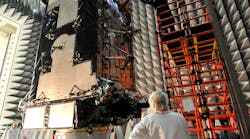With functional testing on a satellite bus just recently completed progress of GPS III has now taken another step forward. A GPS III Nonnon-flight satellite testbed (GNST) has executed a series of high-fidelity pathfinding events. Those events validate the process and facility for vehicle integration checkout as well as signal interference testing, which the GPS III satellites will go through prior to delivery for launch.
During these events, the GNST successfully completed thermal vacuum (T-Vac) chamber trail blazing. In doing so, it demonstrated facility and mechanical and electrical ground equipment integration. The testbed also ran a series of vehicle integration test procedures. In addition, the GNST completed passive-intermodulation (PIM) and electromagnetic-compatibility (EMC) testing. Such testing ensures that multiple high-powered signals—generated from the satellite’s navigation downlink transmissions or transmitted from its hosted nuclear-detection-system payload—do not interfere with each other or themselves.
The GNST is a full-sized GPS III satellite prototype. Its goal is to identify and resolve development issues prior to integration and test of the first GPS III space vehicle (SV 1). The GNST is currently being prepared to be sent to the United States Air Force Station in Florida for further risk reduction testing. The first GPS III space vehicle (SV 1) is set to be launched in 2014.
